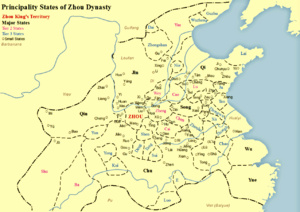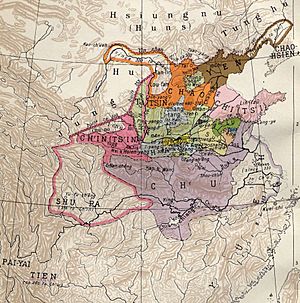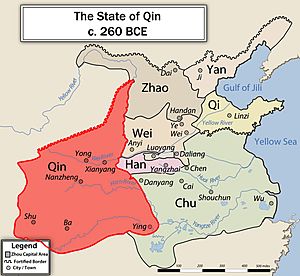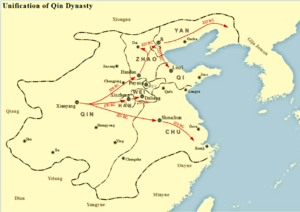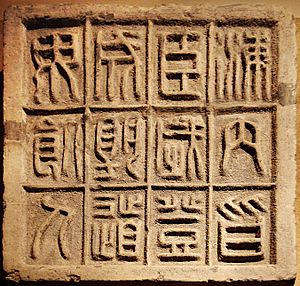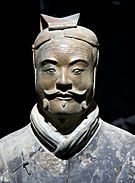Qin dynasty facts for kids
Quick facts for kids
Qin
秦
|
|||||||||||||||
|---|---|---|---|---|---|---|---|---|---|---|---|---|---|---|---|
| 221 BC–206 BC | |||||||||||||||
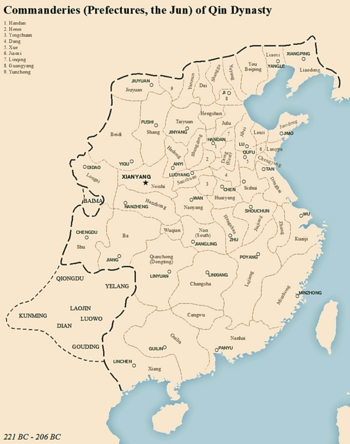
Commanderies of the Qin dynasty
|
|||||||||||||||
| Capital | Xianyang | ||||||||||||||
| Common languages | Old Chinese | ||||||||||||||
| Religion | Chinese folk religion | ||||||||||||||
| Government | Absolute monarchy | ||||||||||||||
| Emperor | |||||||||||||||
|
• 221–210 BC
|
Qin Shi Huang | ||||||||||||||
|
• 210–207 BC
|
Qin Er Shi | ||||||||||||||
| Chancellor | |||||||||||||||
|
• 221–208 BC
|
Li Si | ||||||||||||||
|
• 208–207 BC
|
Zhao Gao | ||||||||||||||
| Historical era | Imperial | ||||||||||||||
| 221 BC | |||||||||||||||
|
• Death of Qin Shi Huang
|
210 BC | ||||||||||||||
|
• Surrender to Liu Bang
|
206 BC | ||||||||||||||
| Area | |||||||||||||||
| 220 BC | 2,300,000 km2 (890,000 sq mi) | ||||||||||||||
| Population | |||||||||||||||
|
• 210 BC
|
20,000,000 | ||||||||||||||
| Currency | Ban Liang | ||||||||||||||
|
|||||||||||||||
| Today part of | China North Korea |
||||||||||||||
| Qin dynasty | |||||||||||||||||||||||||||||||||||||
|---|---|---|---|---|---|---|---|---|---|---|---|---|---|---|---|---|---|---|---|---|---|---|---|---|---|---|---|---|---|---|---|---|---|---|---|---|---|
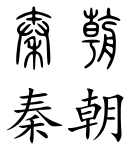
"Qin dynasty" in Qin-era seal script (top) and modern (bottom) Chinese characters
|
|||||||||||||||||||||||||||||||||||||
| Chinese | 秦朝 | ||||||||||||||||||||||||||||||||||||
| Hanyu Pinyin | Qíncháo | ||||||||||||||||||||||||||||||||||||
|
|||||||||||||||||||||||||||||||||||||
The Qin dynasty (pronounced Chin) was ancient China's very first empire! It lasted from 221 BC to 206 BC. This makes it the shortest major dynasty in Chinese history, with only two emperors. However, it started an imperial system that shaped China for over 2,000 years, until 1912 AD.
The Qin dynasty was named after its home region, the Qin state, which is now parts of Gansu and Shaanxi in modern China. It was founded by Qin Shi Huang, who became the First Emperor of Qin. The Qin state grew very strong thanks to new laws and ideas called Legalism. These changes were introduced by Shang Yang in the 300s BC, during a time known as the Warring States period.
The Qin government wanted to create a strong, united country with a powerful army and a stable economy. They took power away from rich landowners and nobles. This gave the government direct control over farmers, who made up most of the population. This allowed them to start huge projects, like connecting walls along the northern border. These walls eventually became part of the famous Great Wall of China.
The Qin also made many important changes. They standardized money, weights, and measurements. They also created a single system of writing for the whole country. These changes helped unite China and made trade easier. The Qin army used the best weapons and fighting methods of their time. Even though the Qin dynasty was short, it had a huge impact on China's future. Its name is even thought to be where the European name "China" comes from!
Contents
History of the Qin Dynasty
How the Qin State Began
The Qin state started around the 800s BC. A person named Feizi was given control over Qin City. This city is now where Tianshui is located. This area became known as the state of Qin.
Later, a leader named Duke Xiang was sent to lead a war trip. During this trip, he officially created the Qin state. The Qin state began to expand its military into central China around 672 BC. By the 300s BC, the Qin had taken control of nearby tribes. This set the stage for the Qin to grow even more powerful.
How Qin Grew Strong
A Qin leader named Shang Yang introduced a new way of thinking called Legalism. This philosophy focused on strict laws and a strong government. Shang Yang's reforms, from 361 BC to 338 BC, made the Qin army very strong. He also helped build the Qin capital city, Xianyang.
Legalism encouraged a practical and tough way of fighting wars. In earlier times, war was seen as a "gentleman's activity." Commanders were expected to follow certain rules. For example, they might wait for the enemy to cross a river before attacking. The Qin, however, ignored these old traditions. They took advantage of their enemies' weaknesses.
The Qin had other advantages too. They had a large, well-trained army and skilled generals. They used the newest weapons and ways to move troops. This allowed them to travel easily across different types of land in China. Because of their ideas and their actions, the Qin were much better at fighting wars.
The Qin Empire also had a great location. It had fertile land and was protected by mountains, making it a natural fortress. Its large farms produced enough food and resources to support its big army. A canal built in 246 BC, called the Wei River canal, was especially important for farming.
Conquering the Warring States
Before the Qin dynasty, China was divided into several major states. These were Yan, Zhao, Qi, Chu, Han, Wei, and Qin. The rulers of these states called themselves kings.
The Qin state faced some challenges before its big conquests. Shang Yang was executed in 338 BC. There were also power struggles within the Qin government around 307 BC. The Qin were even defeated by an alliance of other states in 295 BC.
However, a strong leader named Fan Sui became prime minister. He started an aggressive plan for the Qin to conquer the other states. The Qin moved quickly. They first attacked Han, taking its capital city of Xinzheng in 230 BC. Then they moved north. The state of Zhao surrendered in 228 BC, and Yan fell in 226 BC.
Next, Qin armies attacked to the east and south. They took the Wei city of Daliang (now Kaifeng) in 225 BC. They forced Chu to surrender by 223 BC. Finally, they defeated the last parts of the old Zhou dynasty. They conquered Qi, taking the city of Linzi in 221 BC.
By 221 BC, the conquests were complete. King Zheng, who had become king of Qin at age 9, was now the ruler of all China. He took a new title: Shi Huangdi, meaning "First Emperor." The new emperor ordered all weapons not owned by the Qin army to be collected and melted down. The metal was used to make twelve large statues in the new capital, Xianyang.
Expanding Southward
In 214 BC, Qin Shi Huang secured his northern borders. He sent a large part of his army (500,000 men) south to conquer the lands of the southern tribes. The Qin army was not used to fighting in jungles. They were defeated by the southern tribes' guerrilla warfare tactics, losing many soldiers.
However, the Qin built a canal to the south. This canal was very important for supplying their troops during a second attack. Using this canal, the Qin armies conquered the coastal areas around Guangzhou. They also took the provinces of Fuzhou and Guilin. They even reached as far south as Hanoi. After these wins, Qin Shi Huang moved over 100,000 prisoners and exiles to live in these new areas. The First Emperor was very successful in expanding his empire to the south.
Campaigns Against Northern Tribes
The Qin empire also tried to expand to the north. However, they often struggled to hold onto this land for long. The tribes in these areas, called the Hu by the Qin, were mostly free from Chinese rule. The Xiongnu tribe, living in the Ordos Desert, often raided Qin peasants. This led the Qin to fight back.
A military campaign led by General Meng Tian conquered the Ordos region in 215 BC. Farming was started there. But the peasants were unhappy and later rebelled. The Qin's borders in many directions were difficult to control. Areas like modern Xinjiang, Tibet, Manchuria, and Inner Mongolia were foreign to the Qin. Even areas they controlled militarily were culturally different.
The Fall of the Qin Dynasty

Qin Shi Huang became very worried about dying. He was obsessed with finding a way to live forever. He died in 210 BC while on a trip to the eastern parts of his empire. He was looking for an "elixir of immortality."
After his death, two of his advisors, Zhao Gao and Li Si, hid the news. They changed his will to put his son, Huhai, on the throne. Huhai became Qin Er Shi, the Second Emperor. They thought they could control him and the empire. However, Qin Er Shi was not a good ruler. He executed many officials and princes. He continued huge building projects, increased taxes, and punished anyone who brought him bad news.
Soon, people all over China revolted. They attacked officials, raised armies, and declared themselves kings. Li Si and Zhao Gao also started fighting each other. Li Si was executed. Zhao Gao then forced Qin Er Shi to take his own life.
Ziying, a nephew of Qin Er Shi, became the next ruler. He immediately executed Zhao Gao. Ziying saw that the people were very unhappy. Many local officials had declared themselves kings. Ziying tried to stay in power by calling himself a king among others. But he was not strong enough.
A major revolt began in 209 BC. When rebels led by Liu Bang attacked, the Qin empire could not last. Ziying was defeated near the Wei River in 207 BC and surrendered. He was executed by the Chu leader Xiang Yu. The Qin capital was destroyed the next year. This is seen as the end of the Qin Empire. Liu Bang later defeated Xiang Yu and started the new Han dynasty. Even though the Qin dynasty was very short, it had a huge impact on how future Chinese dynasties were set up.
Life and Culture in Qin China
Daily Life for People
The rich people in Qin China lived similar lives. But the government wanted everyone to be unified. So, they tried to reduce cultural differences between regions.
Most people (over 90%) were commoners and farmers. They usually stayed in the villages where they were born. Farming was common everywhere. Jobs were often passed down from father to eldest son.
Farmers were not often written about in books during the Qin dynasty. Scholars preferred to write about cities and politics. However, the Qin government encouraged farming. Every few years, important officials would take turns plowing a special field. This showed that the government cared about agriculture.
Qin Architecture

Architecture during the Warring States period had special features. City walls were made longer for defense. Sometimes, extra walls were built to separate different parts of the city. Buildings were designed to show power and authority. Tall towers, grand gates, and high buildings helped show this.
Writing and Ideas
The Qin used a writing system based on pictures and symbols, just like the earlier Zhou dynasty. One of the most important things Prime Minister Li Si did was to standardize writing. He made sure all characters had the same size and shape across the country. This helped unite Chinese culture for thousands of years. He also helped create the "lesser-seal" style of writing, which is still used today in art and advertising.
During the Warring States period, many different ideas and philosophies existed. This was called the "Hundred Schools of Thought." But in 221 BC, the First Emperor took control. He ruled with only one philosophy: Legalism.
Legalism was very strict. It said that individuals' rights were not as important as the government's wishes. Merchants and scholars were seen as unproductive. Other philosophies, like Confucianism and Daoism, were not allowed.
There are stories about the "burning of books and burying of scholars." This story says that the First Emperor ordered all books that went against Legalism to be burned. It also said that scholars who refused to give up their books would be killed. Only books about practical things like farming or medicine were saved. However, some modern experts believe the "burying of scholars" part might not be literally true.
Government and Military
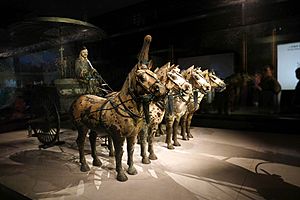
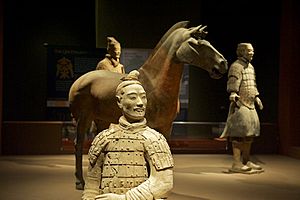
The Qin government was highly organized. It had many officials, all working for the First Emperor. The Qin followed the ideas of Han Feizi, which helped the First Emperor control all his lands. Everything was standardized, from measurements to the length of chariot axles.
The emperor assigned officials to govern the new states he conquered. He did not give these jobs to members of the royal family. This new system ended the old feudal system in China. It replaced it with a strong, central government. This type of government was copied by later dynasties because it was very efficient.
Qin Shi Huang also made the military even stronger. The Qin army used the most advanced weapons of the time. Swords became more common. By the 200s BC, the Qin were using strong iron swords. The crossbow was also very important. It was more powerful and accurate than older bows.
The Qin also used better ways to travel and fight. Other states had started using cavalry (soldiers on horseback) instead of chariots. The Qin quickly adopted this change because cavalry could move more easily across China's varied land.
The First Emperor also planned to protect his northern border from nomadic invaders. This led to the first construction of what became the Great Wall of China. It was built by connecting and strengthening older walls. Another huge project during Qin Shi Huang's rule was the Terracotta Army. This army of clay soldiers was meant to protect the emperor after he died. It was hidden underground and not discovered until 1974.
Religion and Beliefs
The main religious belief in Qin China focused on shen (spirits or gods). People believed in a spirit world that was like the earthly one. They offered animal sacrifices to contact this other world. They believed the dead simply moved from one world to the other. These rituals helped ensure the dead stayed in the spirit realm and brought blessings to the living.
Religious ceremonies were usually held in local shrines. During rituals, people would use smoke, incense, and music to make their senses less sharp. This was to help them feel closer to the spirit world. Leaders of the rituals would fast and meditate to prepare.
People also used spirit intermediaries, or mediums. These people would go into trances or dance to perform supernatural tasks. They often gained power because of their abilities.
Divination was another common religious practice. This meant trying to predict or influence the future. An old practice was cracking bones or turtle shells to learn about the future. People also watched natural events like comets, eclipses, and droughts. They believed these were signs of what was to come.
Where the Name "China" Comes From
The name 'Qin' is thought to be the origin of the modern European name for the country, China. The word likely traveled to other languages as 'Cina' or 'Sina'. Then it became 'Sinai' or 'Thinai' in Greek and Latin. Finally, it became 'China' in English and 'Chine' in French. However, some experts disagree. They suggest that 'Sina' in Sanskrit might have developed earlier. Others think the name might come from the state of Jin or Jing.
Qin Emperors
Qin Shi Huang was the first Chinese ruler to call himself "Emperor." He did this after uniting China in 221 BC. This year is usually seen as the start of the Qin dynasty. It lasted for fifteen years until 207 BC, when civil wars ended it.
| Emperor's Title | Personal Name | Years of Rule |
|---|---|---|
| Shi Huangdi | Zheng (政) | 221 – 210 BC |
| Er Shi Huangdi | Huhai (胡亥) | 210 – 207 BC |
| None | Ziying (子嬰) | 207 BC |
Images for kids
See also
 In Spanish: Dinastía Qin para niños
In Spanish: Dinastía Qin para niños



